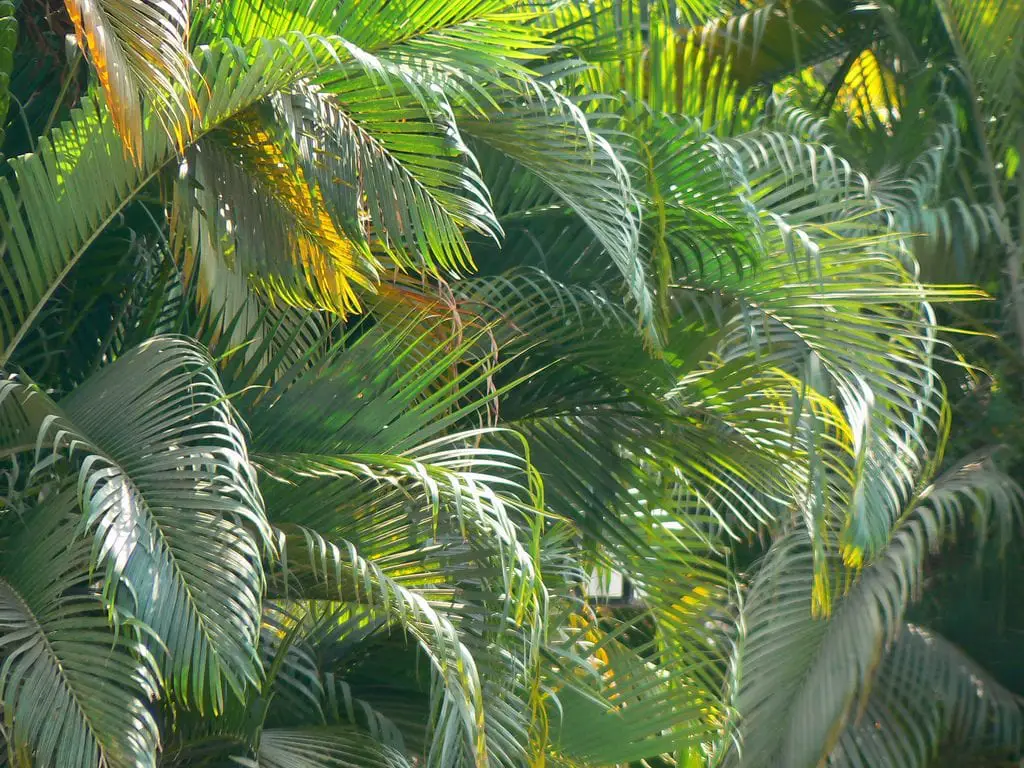The areca palm or Deeply shiningpopularly known as areca, is a spectacular plant. Fast growing, it is beautiful whether it is kept in a pot or in the garden. Perhaps that is why it is one of the best known in the world, since it is also grown quite frequently indoors.
However, there are many things that we should all know if we want to have a copy, because Although it is not difficult to care for, it must be borne in mind that it, like all plants, has its preferences.
Origin and characteristics
Our protagonist it is a multicaule palm tree -of various trunks- whose scientific name is Deeply shiningknown as areca, bamboo palm, yellow palm, or golden fruit palm. It is native to Madagascar. It reaches an average height of 3 meters, but can reach 6m. The leaves are pinnate, arched, green in color and between 2 and 3 meters long. The flowers are grouped in interfoliar inflorescences, and produce yellowish fruits that turn black when mature.
Their trunks are ringed and thinabout 30cm thick, which is why it is ideal for all types of gardens. It can be confused with kentia when it is young, so we attach this video so that you know how to differentiate them:
What are cares?
If you want to have a copy, we recommend that you provide it with the following care:
Location
- Outdoor: in semi-shade, especially if you live in an area with strong sunshine (even if only in summer), such as the Mediterranean region.
- Interior: it must be in a very bright room, away from drafts. Do not put it right in front of the window, as the sun’s rays would burn its leaves due to the magnifying glass effect.
Earth
- the garden: it is indifferent, as long as it has good drainage and is fertile (or regularly credited).
- Flower pot: universal growing medium (you can get it here!) mixed with 30% perlite.
Irrigation
Water your Deeply shining 3-4 times a week in summer, and every 4-5 days the rest of the year. In case of having it in a pot, during the summer you can put a plate under it and fill it up.
Subscriber
From early spring to late summer It must be paid with organic fertilizers, such as compost, mulch, guanohumus u others. If you are going to grow it in a pot, use liquid or granular fertilizers, such as chemicals that are already sold ready to use.
Planting or transplanting time
In springwhen the minimum temperature is higher than 15ºC. If it is grown in a pot, you will have to transplant it every 2 years.
Multiplication
Areca multiplies by seed during spring or summer. The step by step to follow is the following:
- First, a pot of about 10,5 cm in diameter is filled with universal growing medium.
- Second, it is watered and a maximum of two seeds are placed on the surface in such a way that they are slightly separated.
- Third, the seeds are covered with a thin layer of substrate – they should not be seen with the naked eye – and watered, this time with a sprayer.
- Fourth, a label is introduced to which the name of the plant and the sowing date will have been previously written.
- Fifth and last, the pot is placed near a heat source (if it is summer, just take it outside and put it in semi-shade).
If everything goes fine, will germinate in 30-60 days.
Pests
It is quite resistant, however, if the growing conditions are not adequate, it can be affected by:
- Mealybugs: they can be cottony or limpet type. They are deposited on the leaves, especially the most tender ones, from where they feed. They can be removed by hand or removed with an anti-scale insecticide.
- Red spider: it is a red colored mite that causes the appearance of discolored spots on the leaves. In addition, it produces cobwebs, which is why they are often easy to distinguish. They are eliminated with acaricides.
- he is the archon: the larvae of this moth dig galleries in the trunks, causing death in a short time (it can be days in summer). You will see that the central leaf is deviated, and it could flower out of time. If you live in a risk area, do preventive (or curative) treatments with chlorpyrifos and imidacloprid (one month one, and the next month the other).
Diseases
If it is watered excessively, the fungi will affect it. The symptoms are:
- Root rot
- White or greyish powder on leaves and / or trunks
- Pinkish powder at the base of the trunks
- Death of the apex (it is the central leaf, the one that acts as a guide). If you pull it gently, it comes out easily
It is difficult to recover a palm tree affected by fungi, but there are things you must do, such as space the waterings and treat it with fungicide.
Rusticity
The Deeply shining or areca withstands cold and frost down to -2ºCbut they must be very punctual and short-lived frosts. Young specimens – which have not yet divided the leaf – are more sensitive.
And with this we are done. What did you think of the areca? You have someone?




